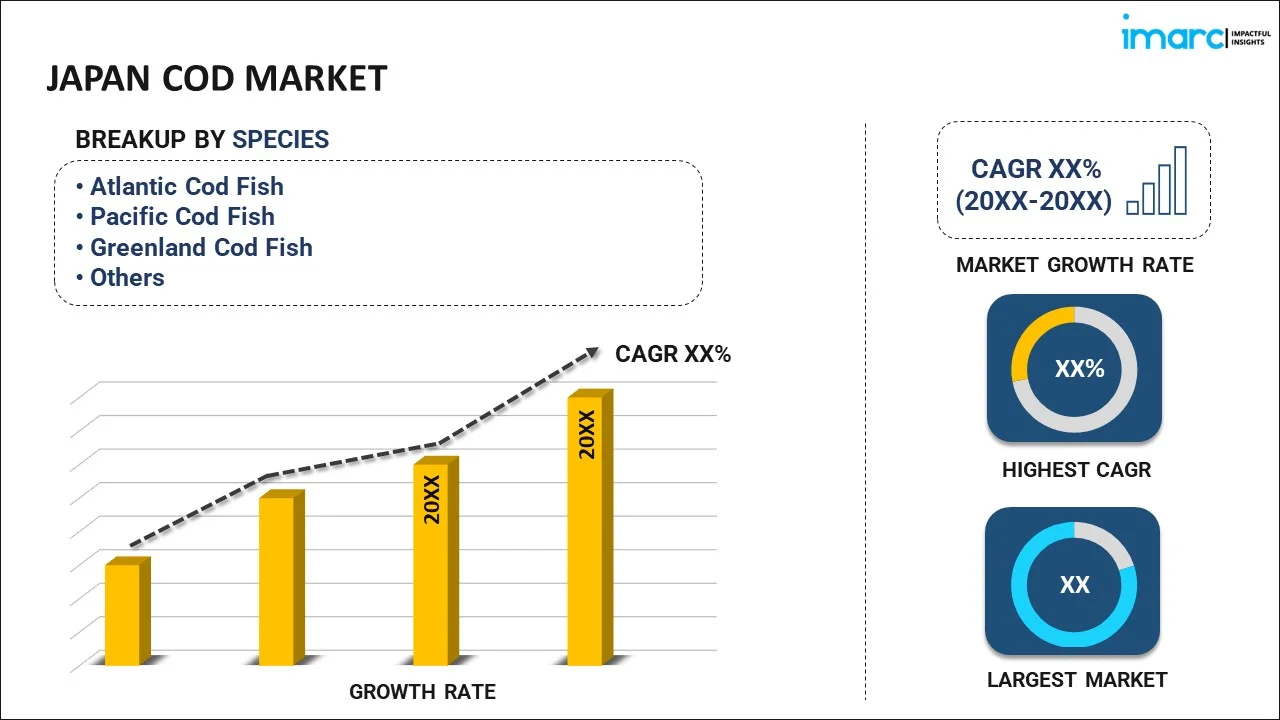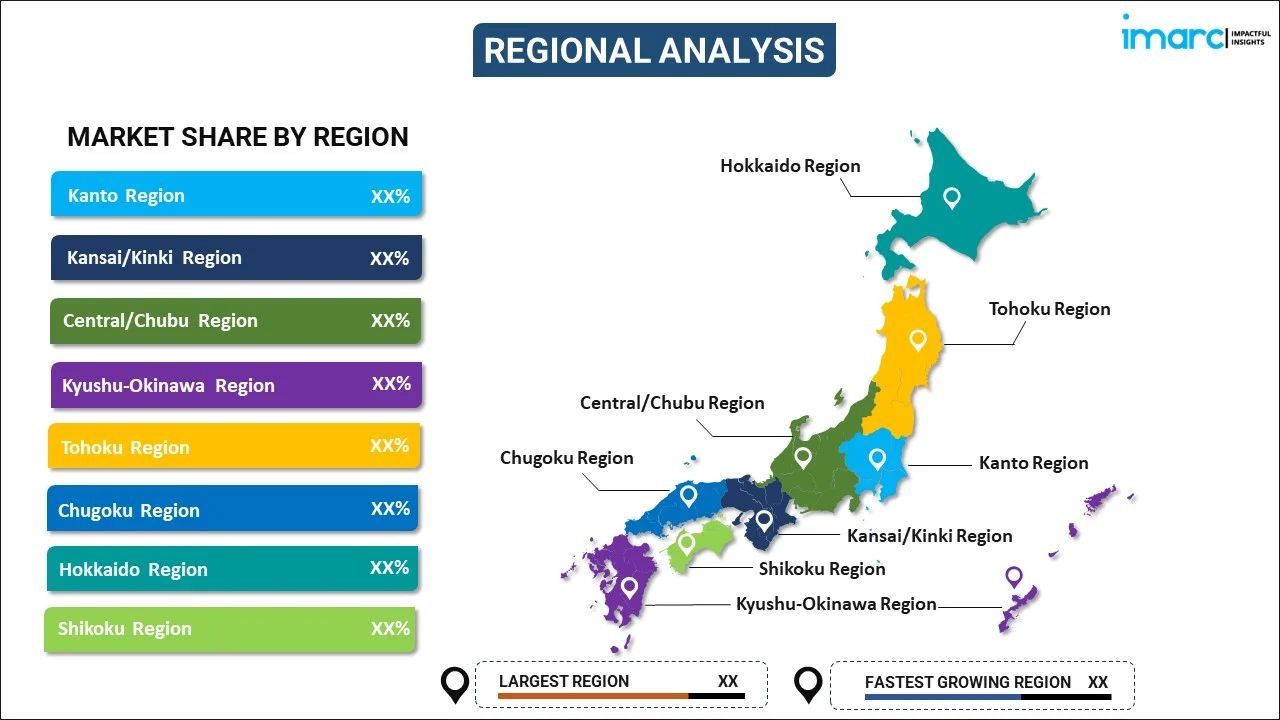
Japan COD Market Report by Species (Atlantic Cod Fish, Pacific Cod Fish, Greenland Cod Fish, and Others), Source (Farmed, Wild Capture), Product Type (Fresh, Canned, Frozen, and Others), Distribution Channel (Institutional, Retail), and Region 2025-2033
Market Overview:
Japan cod market size reached USD 674.0 Million in 2024. Looking forward, IMARC Group expects the market to reach USD 1,007.0 Million by 2033, exhibiting a growth rate (CAGR) of 4.6% during 2025-2033. The increasing advances in processing and technology with improved methods for freezing, packaging, and preserving cod that can extend its shelf life and expand its market reach, are primarily driving the market.
|
Report Attribute
|
Key Statistics
|
|---|---|
|
Base Year
|
2024
|
|
Forecast Years
|
2025-2033
|
|
Historical Years
|
2019-2024
|
| Market Size in 2024 | USD 674.0 Million |
| Market Forecast in 2033 | USD 1,007.0 Million |
| Market Growth Rate 2025-2033 | 4.6% |
Cod is a species of fish that is widely known for its culinary significance and historical importance in various cultures. Scientifically referred to as Gadus morhua, cod is found in the cold waters of the North Atlantic Ocean, particularly in regions such as the North Sea, the Gulf of Maine, and the Barents Sea. Cod has been a staple food source for centuries, dating back to Viking times, and played a pivotal role in the development of fishing industries and trade routes. Its mild, flaky white flesh makes it a versatile ingredient in countless dishes, including fish and chips, stews, and grilled preparations. However, sustainable fishing practices are crucial to preserving cod stocks and maintaining ecological balance in marine ecosystems. Cod's cultural and culinary significance, along with its conservation concerns, continue to shape its role in today's world, where it remains a symbol of the delicate balance between human consumption and responsible environmental stewardship.
Japan COD Market Trends:
The cod market in Japan is influenced by a variety of factors, and these drivers are interconnected in complex ways. Firstly, consumer demand for seafood, particularly cod, has been steadily rising due to its perceived health benefits and versatility in cooking. Consequently, this growing demand has put pressure on the fishing industry to meet supply requirements. However, overfishing has become a critical concern, and stricter regulations have been implemented to protect cod populations, leading to fluctuations in supply. Moreover, environmental factors play a crucial role in cod market dynamics. Climate change has led to shifting ocean temperatures and currents, affecting the distribution and abundance of cod stocks. These environmental shifts can disrupt traditional fishing patterns, leading to supply uncertainties. Additionally, trade agreements impact the cod market. Tariffs, quotas, and trade disputes can influence the import and export of cod products, affecting market prices and availability. Apart from this, technological advancements in fishing techniques, processing methods, and transportation, which have improved efficiency and product quality, are expected to drive the cod market in Japan.
Japan COD Market Segmentation:
IMARC Group provides an analysis of the key trends in each segment of the market, along with forecasts at the country level for 2025-2033. Our report has categorized the market based on species, source, product type, and distribution channel.
Species Insights:

- Atlantic Cod Fish
- Pacific Cod Fish
- Greenland Cod Fish
- Others
The report has provided a detailed breakup and analysis of the market based on the species. This includes atlantic cod fish, pacific cod fish, greenland cod fish, and others.
Source Insights:
- Farmed
- Wild Capture
A detailed breakup and analysis of the market based on the source have also been provided in the report. This includes farmed and wild capture.
Product Type Insights:
- Fresh
- Canned
- Frozen
- Others
The report has provided a detailed breakup and analysis of the market based on the product type. This includes fresh, canned, frozen, and others.
Distribution Channel Insights:
- Institutional
- Retail
- Direct Sales
- Supermarkets and Hypermarkets
- Online Stores
- Others
A detailed breakup and analysis of the market based on the distribution channel have also been provided in the report. This includes institutional and retail (direct sales, supermarkets and hypermarkets, online stores, and others).
Regional Insights:

- Kanto Region
- Kansai/Kinki Region
- Central/ Chubu Region
- Kyushu-Okinawa Region
- Tohoku Region
- Chugoku Region
- Hokkaido Region
- Shikoku Region
The report has also provided a comprehensive analysis of all the major regional markets, which include Kanto Region, Kansai/Kinki Region, Central/ Chubu Region, Kyushu-Okinawa Region, Tohoku Region, Chugoku Region, Hokkaido Region, and Shikoku Region.
Competitive Landscape:
The market research report has also provided a comprehensive analysis of the competitive landscape in the market. Competitive analysis such as market structure, key player positioning, top winning strategies, competitive dashboard, and company evaluation quadrant has been covered in the report. Also, detailed profiles of all major companies have been provided.
Japan COD Market Report Coverage:
| Report Features | Details |
|---|---|
| Base Year of the Analysis | 2024 |
| Historical Period | 2019-2024 |
| Forecast Period | 2025-2033 |
| Units | Million USD |
| Scope of the Report | Exploration of Historical Trends and Market Outlook, Industry Catalysts and Challenges, Segment-Wise Historical and Future Market Assessment:
|
| Species Covered | Atlantic Cod Fish, Pacific Cod Fish, Greenland Cod Fish, Others |
| Sources Covered | Farmed, Wild Capture |
| Product Types Covered | Fresh, Canned, Frozen, Others |
| Distribution Channels Covered |
|
| Regions Covered | Kanto Region, Kansai/Kinki Region, Central/ Chubu Region, Kyushu-Okinawa Region, Tohoku Region, Chugoku Region, Hokkaido Region, Shikoku Region |
| Customization Scope | 10% Free Customization |
| Post-Sale Analyst Support | 10-12 Weeks |
| Delivery Format | PDF and Excel through Email (We can also provide the editable version of the report in PPT/Word format on special request) |
Key Questions Answered in This Report:
- How has the Japan cod market performed so far and how will it perform in the coming years?
- What has been the impact of COVID-19 on the Japan cod market?
- What is the breakup of the Japan cod market on the basis of species?
- What is the breakup of the Japan cod market on the basis of source?
- What is the breakup of the Japan cod market on the basis of product type?
- What is the breakup of the Japan cod market on the basis of distribution channel?
- What are the various stages in the value chain of the Japan cod market?
- What are the key driving factors and challenges in the Japan cod?
- What is the structure of the Japan cod market and who are the key players?
- What is the degree of competition in the Japan cod market?
Key Benefits for Stakeholders:
- IMARC’s industry report offers a comprehensive quantitative analysis of various market segments, historical and current market trends, market forecasts, and dynamics of the Japan cod market from 2019-2033.
- The research report provides the latest information on the market drivers, challenges, and opportunities in the Japan cod market.
- Porter's five forces analysis assist stakeholders in assessing the impact of new entrants, competitive rivalry, supplier power, buyer power, and the threat of substitution. It helps stakeholders to analyze the level of competition within the Japan cod industry and its attractiveness.
- Competitive landscape allows stakeholders to understand their competitive environment and provides an insight into the current positions of key players in the market.
Need more help?
- Speak to our experienced analysts for insights on the current market scenarios.
- Include additional segments and countries to customize the report as per your requirement.
- Gain an unparalleled competitive advantage in your domain by understanding how to utilize the report and positively impacting your operations and revenue.
- For further assistance, please connect with our analysts.
 Inquire Before Buying
Inquire Before Buying
 Speak to an Analyst
Speak to an Analyst
 Request Brochure
Request Brochure
 Request Customization
Request Customization




.webp)




.webp)












